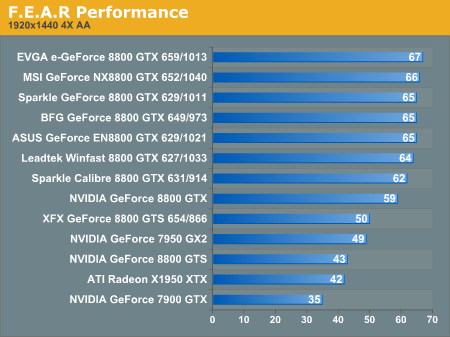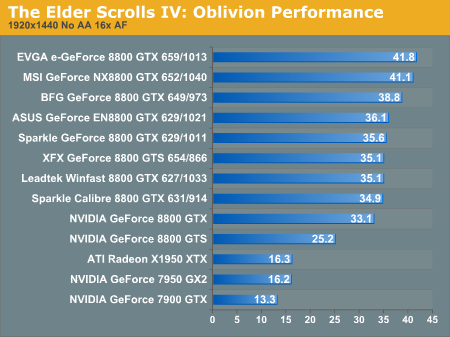GeForce 8800 Roundup: The Best of the Best
by Josh Venning on November 13, 2006 11:04 AM EST- Posted in
- GPUs
Overclocked Performance
Once we achieved our overclocks for these cards, we wanted to see what kind of performance gains we would see with the higher clock speeds. Our test system was the same one we used for the 8800 launch tests:
| CPU: | Intel Core 2 Extreme X6800 (2.93GHz/4MB) |
| Motherboard: | EVGA nForce 680i SLI Intel BadAxe |
| Chipset: | NVIDIA nForce 680i SLI Intel 975X |
| Chipset Drivers: | Intel 7.2.2.1007 (Intel) NVIDIA nForce 9.35 |
| Hard Disk: | Seagate 7200.7 160GB SATA |
| Memory: | Corsair XMS2 DDR2-800 4-4-4-12 (1GB x 2) |
| Video Card: | Various |
| Video Drivers: | ATI Catalyst 6.10 NVIDIA ForceWare 96.97 NVIDIA ForceWare 91.47 (G70 SLI) |
| Desktop Resolution: | 2560 x 1600 - 32-bit @ 60Hz |
| OS: | Windows XP Professional SP2 |
We tested the performance of these cards with two games at the same settings as our performance tests in the 8800 launch article to keep things consistent. The two games we chose for performance testing are F.E.A.R and Oblivion. We tested both games at 1920x1440 resolution, with 4xAA for F.E.A.R, and no AA/16xAF for Oblivion. Our settings for Oblivion were the same as those in our 8800 launch tests, with all quality settings on or at their highest and with HDR enabled. In F.E.A.R. we put all quality settings at their highest, with the exception of the "soft shadows" option, which we feel creates too much of a performance hit given the poor effect it creates.


In F.E.A.R. with the overclock on the XFX 8800 GTS we see about a 16% boost in performance at 1920x1440. In Oblivion we see almost a 40% increase in performance with the overclocked XFX 8800 GTS. Among the 8800 GTX cards, we see that as we would expect the MSI and EVGA samples saw some of the best performance with their overclocks.
In F.E.A.R we see increases in performance of about 14%, and in Oblivion, increases of around 26% between the factory clocked and user-overclocked cards. Keep in mind that with Oblivion, there is some variance (< 5%) in the frame rate between benchmarks because it is a manual run-through of a save game using FRAPS.










34 Comments
View All Comments
yacoub - Monday, November 13, 2006 - link
I was surprised the eVGA card too the lead since the MSI had a much higher memory clock. I guess these cards are nowhere near being fillrate limited, so the core clock boost is more important? I'm not sure if that's the right conclusion to make.Also lol @ the 1950XTX's heinous noise and heat levels. ;)
The power consumption reduction from its die-shrink (right?) over the 1900XTX is nice though.
Very helpful article. Obvious conclusion: Stay away from the Caliber, lol.
kalrith - Monday, November 13, 2006 - link
On page 5, it says that the Calibre "did get a core boost of 31MHz on the core clock". If the stock speed is 575 and the overclock is 631, shouldn't it be a boost of 56MHz?Also, on page 5 the Calibre's memory overclock is listed as 1021MHz, and on page 6 it's lists as 914MHz.
Josh Venning - Monday, November 13, 2006 - link
Thanks for pointing out the errors on page 5, they've been fixed.Kyteland - Monday, November 13, 2006 - link
On page 2: "First we have the (insert exact card name here) from BFG."